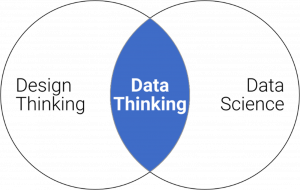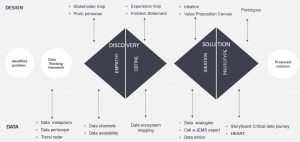How Data Thinking helps to create innovative services
Since the Second World War, researchers have begun to study the following question: “How can we develop our creative abilities in order to improve production? Since then, methodologies like Design Thinking have been able to materialize the answer to this question. Design Thinking is a human-centered approach to innovation that relies on the designer’s toolbox to integrate the needs of people, the possibilities of technology, and the requirements for company success.”
With big data, a new way of doing things had to be found. At JEMS we call it Data Thinking.
The historical context
Our story begins in the 1940s, with war raging in Europe. With the goal of destroying the enemy, a race for science and technology is launched to find more effective strategies, communications and weapons. Sonar for submarine detection, early warning radar for aircraft, Enigma communications coding, the list goes on.
After the war, science and technology turned to the reconstruction of cities and infrastructures, which had to be done quickly and better. The stage was set for research: studying how people think and interact in order to improve and accelerate production.

Better thinking for better creative processes and creativity
Max Wertheimer (1880-1943) in his book Productive Thinking (published 1945) explores what happens when people think productively. What is the process? What are the requirements? Is there such a thing as “good or bad thinking”? And finally: can it be improved? He thought that traditional logic stimulates thinking. But that logic alone did not lead to productive thinking or new ideas. He brought the notion of insight to logic.
Arnold (1913-1963) taught creative engineering at Stanford. He wanted to understand the process of invention by studying it scientifically. Arnold broke with the common approach of giving engineering students highly specific problems that, by definition, have only one correct answer. In practical life, design begins with studying a situation and the environment to define what people need. He brought a scientific organization to a creative process by basing the process on analysis and synthesis in 4 steps: question, observe, associate and finally predict.
David Kelley, founder of the innovation company IDEO and the d.school at Stanford University believes that everyone has the capacity to be creative and in his book “Unleashing the Creative Potential Within Us All” he advocates the idea that we are all creative. In our early childhood we enjoy imaginary games, we ask crazy questions, we draw spots and call them dinosaurs. But he notes that as we become adults, socialization and formal education stifle these impulses. We learn to be wary of judgments, to be more cautious, more analytical. David Kelley provides conditions that encourage and boost creative confidence.
Recent examples of products and services related to Design Thinking.
Now that we know the context, what are some things that have been created recently through Design Thinking? Netflix, AirBnB, the Oral B electronic toothbrush, Uber Eats, PillPack, a home drug delivery system, to name a few. We notice right away that these innovations are all based on data.

What is Data Thinking?
We have seen Productive Thinking and Creative Thinking. We can also include Systems Thinking and now Data Thinking. The common dimension: obviously “thinking”. In every era the needs of society change and people from different backgrounds look to the Zeitgeist for solutions; the prefixes in some way “productive, creative, systems”… The Zeitgeist today is “data” and at JEMS it is obvious that it must be an integral part of the methodology we use to bring solutions to life.
Our starting point is the same: what is the problem? Since we are “Data Thinkers”, we consider that the data is also part of the problem. First, we “observe” the user and his use of the data. Then, we “associate” the different elements of the problem, the data, its impact on the user by imagining data centric solutions. Finally, we build prototypes to get feedback from the user in order to “predict” and decide to implement the solution, modify it or stop the track. At JEMS we have adapted the design thinking and research of Liza Kayser of the University of Twente, Roland Mueller of the Berlin School of Economics and Law and Tizian Krosbien of Dlighted embodied by the Data Innovation Board to produce scalable workshops to answer our clients’ question “what are we going to do with our data?”

Conclusion
Is design thinking outdated? SAP (Security Assurance Plan) is certainly not, as you can see, since its embryonic stage after the Second World War, it has constantly evolved and enriched itself. This is the very nature of design thinking, it is iterative, evolving and adapting to new contexts and concepts, which makes it a survivor of passing trends. Is data thinking the next trend? Certainly not, it is one of the change(s) in our world of data. The ingredients of design thinking are the needs of people, the possibilities of technology and the demands of business success. As Phil Gilbert, head of design at IBM, said, “I feel like the ingredients in my gumbo are the same as everyone else’s, but I put a different emphasis on the ingredients in the validation.”
Design thinking has always been a good idea. Finding out what your customers need and selling products that meet those needs is just good business sense. When you bring in your customers’ data and the data that would be useful to them, you get more accurate insights and more possibilities for better solutions to meet those needs.

Dominic DANGERFIELD – Coach Design Thinking





